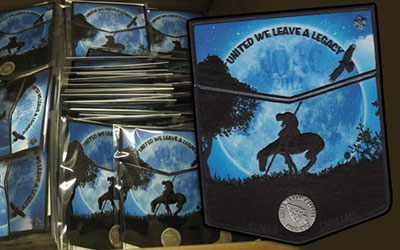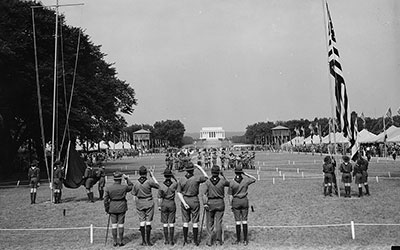The 2013 National Scout Jamboree promises to be a Jamboree like never before. Yes, it will feature all the things you’ve come to expect, such as patch trading, SCUBA, arena shows, and Technology Quest; but there’s more. Scouting.org describes it as “high adventure like you’ve never seen”—whitewater, climbing, zip lines, mountain biking, and much more. All of this will take place for the first time at the National Scout Jamboree’s new permanent home: The Summit, in West Virginia. How exciting!
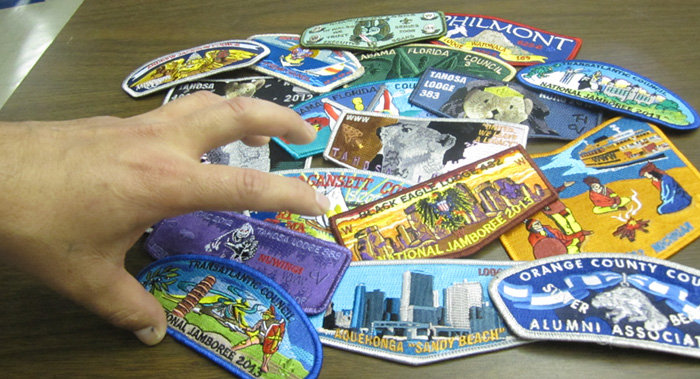
But it’s not always fun and games. Although you probably think theft at a major Scouting event such as Jamboree would not happen, it has happened in the past and will likely continue in the future. What is the item most likely to be stolen? Boy Scout patches. Shocking indeed was the amount of patch theft that occurred at the last National Scout Jamboree. Yes, it happens, usually with the thief having at least one or two co-conspirators to distract the trader. The only way to eliminate or at least greatly reduce this sad occurrence is not to minimize it, and thereby become informed about how to protect ourselves and one another.
Stories, Rumors, and Speculation
At a past Jamboree, a youth set his 8-inch thick patch book on the ground right next to his chair in the trading tent. When he reached for it a little while later, it was gone. The book was found the next morning under a tree about 30 steps away from one of the campsites, with the empty patch pages piled next to it. Somebody had gone to the trouble to strip all the patches out of the pages. Reportedly, the youth gave up collecting patches altogether, as it had been a combined father-and-son collection. On a similar note, about 10-15 years ago, someone entered a scout’s tent when he wasn’t there, and took his entire bag of patches. They found the empty bag in the nearby woods.
A Scouter from Texas, who wishes to remain nameless, shares his theft story. “I was almost 16 years old when I attended the 1981 Jamboree. I was the only person from my hometown and it was a real struggle for my family to send me. I did not have that many patches to trade when I went in 1981 . . . I walked into a tent in my Jambo troop and saw some of my patches lying on the floor. I was mad and I rounded up all of my patches, but I don't think I reported the guy (he was in the tent when I went in; he tried to laugh it off). Later at the Jambo I tracked down a guy from another Council that I'd gone to Philmont with the prior year. When trading with him I saw patches that I knew he'd stolen from me at Philmont (he admitted it and gave them back). There were plenty of patches stolen at the '85 Jambo. I remember one Scout standing up at the Trading Tent and yelling at everyone there that stuff was getting stolen left and right and everyone was supposed to be a Scout.”
Scouts aren’t the only ones who fall victim to stolen patches.
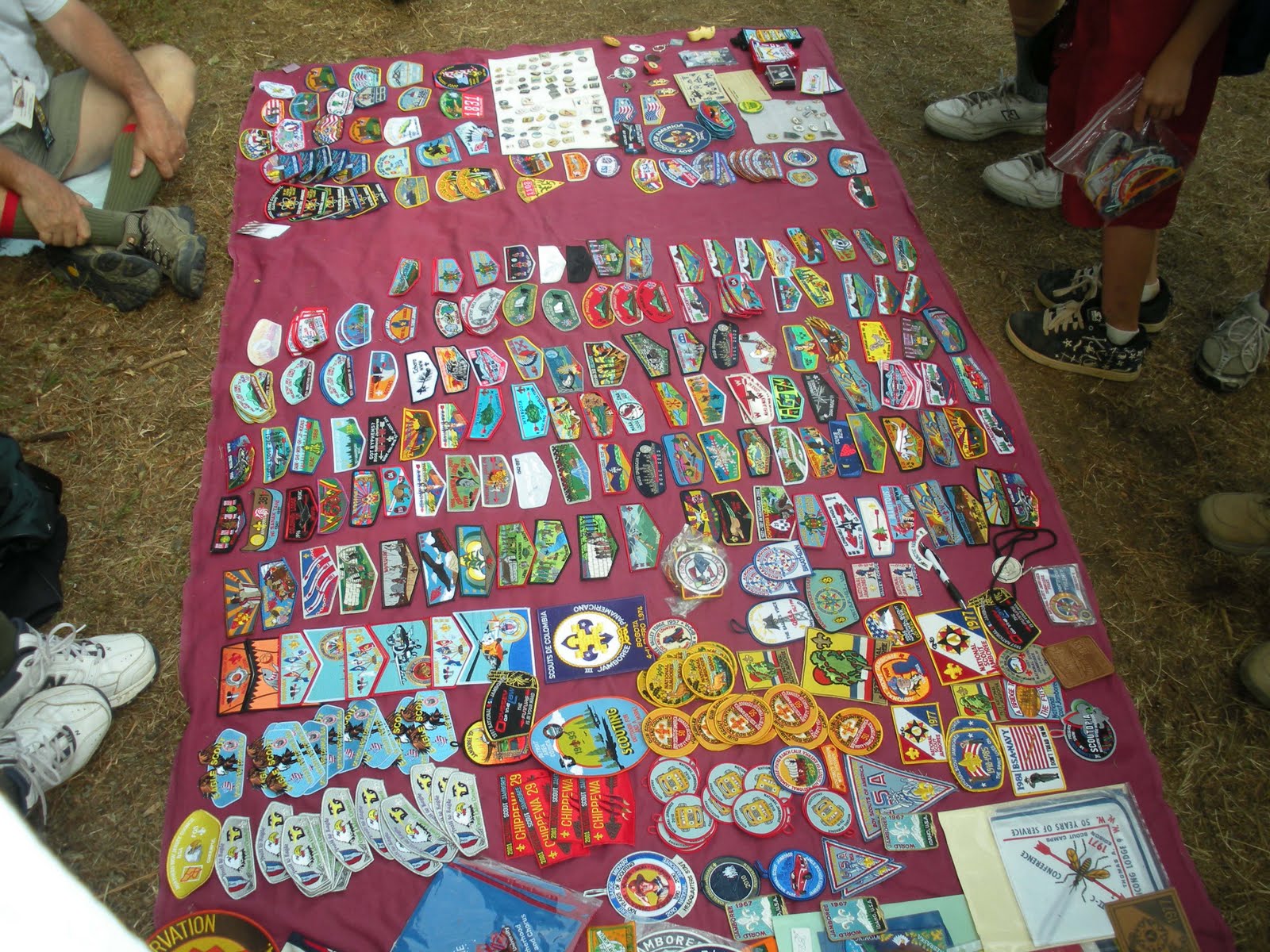
Scout leaders and adult patch collectors do as well. A lodge chief of Anpetu-We Lodge in 1986 relates the following story:
“I was at our Lodge Officer Training event at Camp Lewallen, and had my patch collection in a gallon zip-loc bag in the rear seat of my 1979 Plymouth Volare, parked outside our dining hall with the windows open and unlocked (scout camp, right?). [It was a] very small event, with only our Lodge and Chapter officers and adult advisers present. There couldn't have been more than 25 or 30 people there. When I was loading the car to go home, alas, no patches. Nobody fessed up. Someone now has a mint Lodge 100 F1 in their collection that used to belong to me, and what's more disappointing is that I was given that mint F1 from a friend of my father after he learned I had been elected lodge chief. He had been the lodge chief 20 years earlier, and took it out of his personal collection as a gift of congratulations to me. I now have another F1 (not as nice), but that patch can never be replaced.”
Near Misses and Hope
Tod Johnson, ISCA VP of Finance for ScoutTrader.org shares his experiences: “[In the] Early 90s when I was a Lodge Adviser and trading late night at an NLS, another Scouter left his case (with his Victorio in it) near a couch and went to bed. As usual, I was the last up and saw the case and knew who[m] it belonged to and the next morning, when I opened the door, this Scouter was pacing up and down the hall. I asked if he was missing something and was he relieved when I handed it to him, as I had it for safe keeping.”
And then last NOAC I found a daypack left in one of the cafeterias and opened it and there was a name inside from one of our California lodge contingents. Knowing the contingent leader, [I] figured it was better to return to him, and was his youth happy! So a lesson here for contingent leaders: make sure your youth has a card or ID—something to help return lost knapsacks, etc—at those national events or any event.”
There is still plenty of good in the world. Tod goes on to relate: “I have [heard] of many patch thefts, and one of the things I like is how others will donate a patch back to that youth or whomever so that his experience isn't totally ruined. I guess when adult leaders see that happening to one of the youths in the unit, they need to understand the situation (even if they themselves don't collect) and put out a good word to help the youth.”
10 Ways To Prevent Patch Theft
Unfortunately, theft of Boy Scout patches is nothing new. The sad truth is that as long as people have something that others do not have but want, the theft will continue. But you can help reduce it by employing the following ten strategies when you attend this year’s National Scout Jamboree. Here are some common-sense steps for keeping your items secure.
1. Have a container in your tent that you can lock. Keep your valuables locked up when not in use. Just take out the patches you're going to trade that day and leave the rest locked up.
2. Be low-key. Don't brag about the number of patches that you've brought or traded for. Likewise, don't put out too many patches on your trading blanket—not just for security; if another Scout thinks you have a lot of patches, he might expect more for his patches in trade. The more stuff on your blanket the harder it is to keep an eye on things and the more you stand to lose if things are stolen.
3. Trade with only one Scout at a time. Ask Scouts to form a line if necessary. You'll hear rumors of people who work in groups where some distract and others steal.
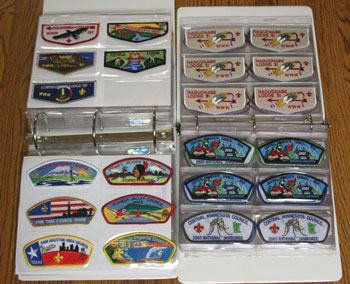
4. If you're trading on a blanket consider using notebooks with plastic pages. The plastic pages help keep the patches together until a swap is negotiated.
5. Leave patches that you do not want to trade at home. If a friend or relative gives you some older patches, you should probably keep them rather than trade them. If you do decide you want to trade them, see if you can get an idea of their value on eBay prior to the Jamboree.
6. Prior to the Jamboree, ask your Jamboree troop leadership to lay down the law on stealing. "Now with all the cell phone cameras around, there's a good chance that misdeeds will be caught on film. Do you really want to risk being sent home, possibly with a criminal record, because of a few patches?" Report any theft you see.
7. Print out a one-page sheet with pictures of your patches - "My OA lodge flap, my council strip, and my council's Jamboree patch(es); I will trade these one-for-one for ones I do not already have. Make me an offer." Maybe laminate it so it lasts and doesn't blow away. Maybe laminate a smaller version for your lanyard. Then you can keep your patches in your backpack/fanny pack where they are more secure and you can bring them out only for a trade.
8. Once you've traded for a patch you want to keep, put it away immediately. If you have a fanny pack, put the patches you want to trade that day in ziploc bags (maybe your OA flaps in one ziploc and your JSP's in another) and put those bags and some empty bags in your fanny pack. When you trade for patches you want to keep, put them in the empty bags to keep them separate.
9. Make sure your name, Jambo troop #, and home address are on your backpack / fanny pack / patch notebooks. If you're missing something, check Lost & Found. It might be lost and not stolen.
10. Understand that there are no must-have patches. History has shown over and over again that patches that seem so valuable now are much cheaper after the Jamboree, and they can be easily acquired via the Internet.
This list was provided by the anonymous scouter from Texas, quoted earlier. You are free to copy this list and modify it as you see fit.What Some Scouts Have Tried
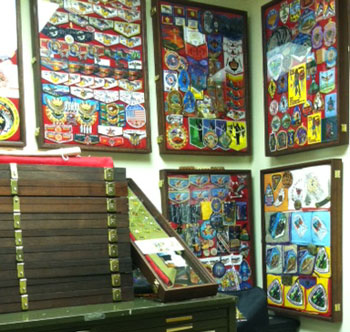
Several youths opt to put plastic over their patches to prevent them from being stolen. Others have had a designated "runner" enforcer who wasn't trading to chase down anyone that stole something from their friends. One Scout took to putting his patches in a wagon and putting a heavy metal mesh cover over the top to stop the constant pilfering. As crazy as it sounds, Scouts also have had to ensure their patches don’t fall to the ground, since some kids attach tape to the bottoms of their shoes, step on patches, and walk away with the patches attached.
Don’t Lose Faith In Scouting!
Baden Powell had a hope that Scouting would help to bring about world peace and understanding. While that was a grand hope, Scouting has made a difference for many people and will continue to do so.
It is easy to see the bad and not the good of what is happening. Putting on a uniform does not suddenly transform a boy into a Scout, and a pledge is a goal that most of us would like to see but may not always achieve. What putting on a uniform does do is give him a more clear cut path along with his home, church, and those things that should represent “the higher vision” of life. For some who may be teeter-tottering between the high road and the low road, Scouting can help shape, mold and transform a youth. For those already with a strong foundation it can make it even stronger. All organizations are made up of people and we all bring expectations to our church, scout unit, district, etc, that may not be the goals of others. Scouting is just one part of a much bigger pie when it comes to the life choices that boys make.
“You can't blame Scouting when a boy picks up the uniform but leaves behind its values. Scouting really isn't the uniform or the badges—it's about values, thinking about others first, about adults being a positive role model, about not keeping score when you do a favor.”—Kevin Doyle
Unfortunately, the stories that we often remember of a young man, or adult for that matter, are when bad choices are made. When people make good choices we often forget or never hear about them to begin with, because doing the right thing is what happens all the time.
Scouting can be proud in its 100+ years of all the successes of boys that it has helped guide, motivate and develop into the citizens they became. Lets not dwell on the failures, as they only represent a small number in the big picture.
In Conclusion
Hopefully you are now more informed and better equipped to keep your patch collection safe at the 2013 National Scout Jamboree and all other Scouting events and trades in the future. There is speculation about security cameras being installed to monitor the trading at the coming Jamboree, but so far that’s all it is—speculation. The planners of the event say patch trading will be limited to certain times and places. Still, it’s ultimately up to each Scout and collector to take responsibility for his own patch collection
Thanks to the many members of patch-L for your comments and contributions!

